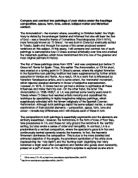The composition in both paintings is essentially asymmetric and the elements are similarly assembled. However, the horizontals, in the form of rows of floor tiles, take precedence in EA, and these not only ground the narrative in the ‘earthly’ setting, but also evoke a sense of order and tranquillity. In contrast, LA is a predominantly a vertical composition, where the spectator’s gaze is in flux and continuously carried upwards towards the heavens. In fact, the heavenly firmament dominates the composition. This is due to the more detailed and animated depiction of the angels, the prominent symbolism of the white dove (representing the ‘Holy Spirit’) and the ‘burning bush’ (signifying that Mary remained a virgin even after conception) and Gabriel who gazes down reverently, poised on a puff of cloud. In EA, the Virgin’s surprise is captured as she sits in her room, whereas in LA, we are not quite sure where she is; we see a hint of the dais, the steps, and the weaving basket, but otherwise she is very much surrounded by the same mysterious swirl of clouds as the celestial beings.
In line with the norms of sixteenth century Italian painting, El Greco uses linear and aerial perspective in EA to convey depth. We can see how the rows of floor tiles transform into a sloping, nondescript stretch of plane, which converges towards a vanishing point. Similarly, space is created by the warmer colours in the foreground, which project towards the spectator and the cool, light blue sky, which recedes into the background. In LA, however, there is no spatial depth and no such perspectival tools can be perceived, save for the foreshortened wings of the angel and the white dove – the latter rendered so extremely that it almost pierces through the picture plane. The spectator seems to be looking at the Virgin and Gabriel from below – which would be expected as this was created as an altarpiece – yet, this effect does not extend to the cluster of angels above, leading to a feeling of disorientation.
As with space, El Greco’s treatment of form also differs in each of the paintings. In EA, the various poses of the nude cherubs, the contours of the Virgin’s body and the exposed leg of Gabriel shows that El Greco knew the basics of proportion and anatomy, but decided to eschew such representational techniques in LA. Here, the unnaturally long bodies of the figures are covered in loose drapery that only reveals pallid faces, hands and feet and it is the stark chiaroscuro over the folds of the garments rather than the skin, which imparts volume, albeit in a less defined, fluid manner. Whereas the light falls quite uniformly across the canvas in EA, with very subtle chiaroscuro, the tonal contrast is LA is very pronounced. At first glance, the source of light seems to emanate from the Holy Spirit, illuminating the faces of the Virgin and Gabriel dramatically, but other highlights on the angels suggest that there are other, unexplained sources of light. This strange and selective lighting, coupled with the over-long bodies suffuse the picture with a sense of otherworldliness that is lacking in EA.
The tonal differences find counterpart in the distinct colour palettes of each painting. EA, with its warm, earthly hues reminiscent of Titian, feels like a daytime scene, whereas LA’s cool grey-blues are decidedly more nocturnal. The colour harmony in EA is achieved by the Virgin’s blue robe, which complements the orange-umber background and echoes the light lazurite skies behind Gabriel. Although the Virgin was traditionally depicted in blue, El Greco elects to clad her in cool, madder red in LA (though still adding a midnight-blue cape), which along with the other splashes of vermilion, orange, and incandescent yellow, stand out sharply from the ashen backdrop to create chromatic tension, underscoring the spiritual drama of the narrative achieved by all the other pictorial elements we have looked at.
This comparison of these two paintings clearly illustrates just how much El Greco’s style evolved over the years and reflects the many-faceted influences he came under, culminating in an idiosyncratic style characterized by elongated figures, mystical and supernatural realms, compressed space and exaggerated contrasts in tone and colour. He had no qualms about rejecting norms of proportion, perspective and form if these did not support his pursuit for an intensely personal artistic expression. The rediscovery of his work in the late 19th century and his subsequent influence on the likes of Delacroix, Picasso and Pollock are a testament to the fact that El Greco was most definitely an artist ahead of his time.
References:
- Grove Art Online
- The Oxford Companion to Western Art, Online edn
-
Gombrich, E.H., The Story of Art,15th edn, London: Phaidon Press Limited
- ‘Museo Thyssen-Bornemisza, Madrid
- Museo Prado, Madrid
- Wikipedia, http://en.wikipedia.org/wiki/El_Greco
- The Web Gallery of Art, http://www.wga.hu/frames-e.html?/html/g/greco_el/index.html
- The National Gallery of Art http://www.nga.gov/collection/gallery/gg29/gg29-over1.html
Oil on canvas, 117 x 98 cm, http://www.museothyssen.org/en/thyssen/ficha_obra/375
http://www.museothyssen.org/en/thyssen/ficha_obra/375







